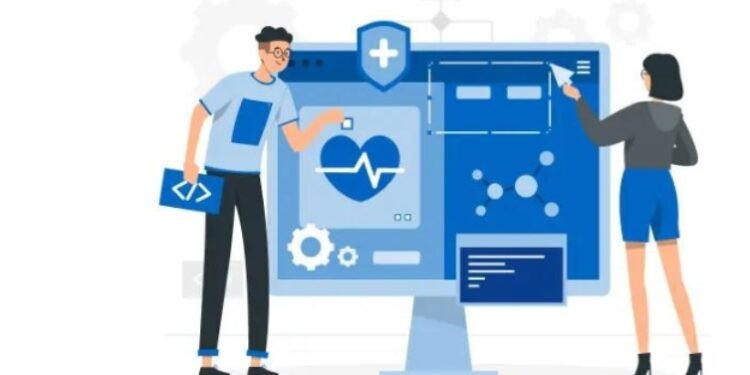Do you agree to the fact that any healthcare organization needs a website to run in this competing world?
We believe you do! A healthcare web app is a valuable tool that has become necessary throughout the years.
There was a time in 1965 when Americans were the only ones who got medical care. And now the tables have turned. Almost eighty percent of people search for medical information on the web and many of us even book appointments over the internet.
As we go more digital, it gets really important for healthcare units to transform with time and serve in a new and digital way: “healthcare web development”. It can redefine the way medical services and processes are being undertaken.
If you are planning to invest in or think of it, this article will give a detailed idea about the design, features, and cost of website development services in healthcare.
So, let’s get started.
What is Healthcare Web Development?
Healthcare web development involves creating websites and apps personalized to the needs of medical institutions and patients. Unlike other web development fields, healthcare web development focuses on features like appointment scheduling, medical information dissemination, and patient-doctor interaction. With the rise of digital healthcare, developers are designing platforms to facilitate remote patient management and secure data exchange. These applications empower patients to access medical services conveniently while providing medical professionals with tools for efficient healthcare delivery.
Healthcare Web Development: Design
- User Experience
User experience is extremely crucial in healthcare web design as patients spend only a fraction of their time in hospitals. Seamless navigation, speed, and informative content are crucial for retaining users. People expect attractive interfaces and quick access to information, making a positive user experience essential for healthcare organizations to maintain patient engagement and satisfaction.
- Valuable Content
In the patient-centric healthcare industry, self-service and patient engagement are equally important. Tailoring website content to patients not only meets their high demand for reliable healthcare information but also helps them to make informed decisions, leading to potential cost savings in treatment. Additionally, doctors also benefit from dedicated portals or separate sites with relevant content.
- Optimized and Integrated
The complexity of healthcare services necessitates highly specific devices and data sharing, raising security and privacy concerns. Despite this, centralized data storage offers streamlined back-end processes, cost-effectiveness, and potential innovations like automation and improved diagnostics. Any website redesign must address interoperability challenges posed by the fragmented nature of the healthcare sector.
- Bright Colours
Medical websites are now favoring bright colors and engaging animations for a fresh look. Professional UI/UX Design companies specialize in creating visually appealing sites that meet healthcare organizations’ needs, enhancing communication and online presence effectively.
- Responsive Web Design
Responsive website design ensures user-friendliness across various devices and screen sizes. With the prevalence of smartphones and tablets in accessing medical information, it’s crucial for medical websites to adapt to different screen resolutions. Statista reports that nearly half of all web traffic comes from mobile devices.
- Flat Design
Flat design employs minimalistic and concise elements in user interface design, resulting in a simple yet visually appealing interface that emphasizes website content. By using basic design elements, flat design can enhance website loading speed, providing users with a seamless browsing experience focused on content.
Features to Integrate in Healthcare Web App
For Medical Providers:
- User Management
An EHR is integral to medical web design, offering real-time access to patient records, treatments, and diagnoses. It helps doctors to enhance decision-making and streamline patient care, eliminating the need for redundant checks.
- Resource Scheduling
Resource scheduling includes reminders and appointment scheduling, enabling doctors to efficiently manage their time, track schedules, and minimize no-shows for optimized patient care.
- Remote Monitoring
A medical website should include telemedicine to let doctors check patients’ health from afar, crucial when a patient can’t visit. It helps prevent serious issues by letting doctors quickly notify patients of health changes and provide online advice and treatments.
- Prescription Tracking
Prescription tracking in medical software allows doctors to generate and send prescriptions directly to patients. This makes the treatment process faster and reduces errors from unclear handwriting, enhancing clarity and efficiency in patient care.
- Feedback and Surveys
Adding a survey feature to the platform helps to know the level of patient satisfaction and identify areas for improvement, crucial for enhancing user retention. Additionally, survey data informs market research, guiding the development of impactful wellness programs.
- Secure Communication
Lastly, it’s essential to offer medical staff a secure communication platform where they can discuss cases, consult colleagues, and share opinions confidently, ensuring confidentiality and safeguarding patient information from unauthorized access.
For Patients
- Profile Management
Profile management is crucial for patients on a healthcare platform, offering easy access to personal health data without paperwork. It should support multiple profiles, catering to diverse needs within families or groups.
- Bill Payment Forms
Integrating a secure payment gateway into medical software enables patients to conveniently pay for services and manage transactions within the app, enhancing user experience and operational efficiency.
- Secure Authentication
Secure user registration is crucial in medical web solutions to protect patient data from unofficial access and breaches. It should be straightforward to complete, ensuring ease of use without deterring users from using the app.
- Custom Virtual Visit Solutions
Patients need the ability to contact doctors from home for virtual visits, especially during emergencies. These solutions gained popularity during COVID-19 and continue to be highly sought-after on medical websites for their convenience and accessibility.
- Prescription Requests
Including a feature for online prescription requests and refills is essential, making it easier for users to manage medications and decreasing the chance of errors.
- Patient Community
Consider integrating a patient community feature into your medical web application. Sharing experiences among patients can be inspiring and supportive, particularly for serious conditions such as cancer, autism, and chronic respiratory diseases.
For Administrators
- Admin Module
A healthcare solution needs an admin module for managing hospital operations. It assigns roles, controls access, and ensures smooth platform functioning, addressing technical issues to maintain operational efficiency.
- Integrations With External Systems
Medical platforms often rely on third-party tools, so it’s crucial your platform can smoothly connect with other software through APIs.
- Analytics Tools
The application should include a feature to monitor patient activities, enabling medical institutions to gather and analyze data for improving service quality and patient care.
Additional Features
Once your healthcare portal’s core features are validated with the MVP, consider enhancing it with additional features to further polish your web solution.
- Chatbot
Try to add chatbots for constant customer support, ensuring users have help at any time. This enhances the user experience and attracts more customers to your platform.
- AI Capabilities
AI goes beyond chatbots in healthcare by helping doctors in diagnosing conditions, predicting patient outcomes, and suggesting personalized treatments using historical data and trends.
- 3D Tours
Consider adding a 3D virtual tour feature to your hospital website. It sets your facility apart and helps new patients familiarize themselves with the hospital layout before their visit.
- Demonstration of Medical Procedures
You can also enhance your hospital website with interactive AR and VR demonstrations of medical procedures. This gives visitors a unique and engaging experience.
Healthcare Web Development: Cost
Healthcare website development costs vary widely depending on factors like the type of website, development team, and location of developers. For physicians and hospitals, investing in online healthcare facilities, telemedicine platforms, and corporate websites can range from $5K to over $200K. The complexity of the site determines the cost, with corporate sites generally costing more due to their comprehensive features.
The development team’s composition also impacts costs, whether it’s an in-house team, outsourcing agency, freelancers, or a local website development company. Additionally, the developers’ location, whether in Europe, Asia, Australia, or the US, influences expenses.
Aside from development, there are other costs to consider such as one-time setup fees, hosting services, cloud integration, HIPAA compliance, SEO, online advertising, and social media management. Customer service systems, online payment apps, and chatbots add to the expenses.
A basic healthcare website may start at $2K-$3K, while corporate sites can exceed $5K. Comprehensive hospital management systems can cost upwards of $80K, depending on feature complexity. The final quote depends on the specific needs and requirements of the healthcare provider.
Wrapping Up!
Developing a healthcare web application is a challenging journey that demands careful attention to detail. From researching about market competition to crafting a modern, user-friendly design and selecting the right technology stack, every step requires expertise and compliance with industry standards.
Hire professionals from a top-notch healthcare app development company that specialize in such building a power-packed healthcare app backed by deep industry knowledge. Collaborating with these development partners can help you transform your vision into a functional reality.


















